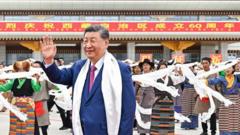In a vibrant display in Lhasa, Xi addressed a crowd of 20,000, hailing local leadership for their efforts against separatist movements—a term that encapsulates Tibetan calls for increased autonomy or independence. His focus on maintaining "political stability, social stability, ethnic unity, and religious harmony" reflects Beijing’s strategy to suppress dissent while asserting its presence in traditionally Tibetan areas.
Making no mention of the Dalai Lama, whose influence remains palpable even in exile, Xi reiterated the Chinese Communist Party's (CCP) narrative of progress in Tibet over the last six decades, which is often contested by human rights advocates. While the CCP heralds improvements in living standards and infrastructure, many Tibetans feel that their cultural identity is under siege, as evidenced by reports of oppressive governmental policies governing religious practices and education.
State media portrayed Xi’s visit as a jubilant celebration, with images of welcoming crowds, traditional dancers, and a message of hope for increased economic and cultural exchanges. However, this narrative is complicated by recent developments, including the controversial construction of the world's largest dam on the Yarlung Tsangpo River. Experts have raised alarms over potential environmental impacts and geopolitical tensions it could provoke, particularly regarding water control against neighboring countries.
Xi's address also included a call for increased regulation of religious practices, pushing for Tibetan Buddhism to align with socialist values—a move seen as part of Beijing's broader effort to exert control over religious institutions in the region. As contradictions between state narratives and on-the-ground realities persist, the trajectory of Tibetan governance remains uncertain, with an increasingly assertive Chinese state juxtaposing against deep-rooted cultural aspirations for autonomy.
Ultimately, this visit encapsulates the ongoing struggle over identity, governance, and the future of Tibet as its people navigate the complexities of their autonomy under the watchful eye of the Chinese government.
Making no mention of the Dalai Lama, whose influence remains palpable even in exile, Xi reiterated the Chinese Communist Party's (CCP) narrative of progress in Tibet over the last six decades, which is often contested by human rights advocates. While the CCP heralds improvements in living standards and infrastructure, many Tibetans feel that their cultural identity is under siege, as evidenced by reports of oppressive governmental policies governing religious practices and education.
State media portrayed Xi’s visit as a jubilant celebration, with images of welcoming crowds, traditional dancers, and a message of hope for increased economic and cultural exchanges. However, this narrative is complicated by recent developments, including the controversial construction of the world's largest dam on the Yarlung Tsangpo River. Experts have raised alarms over potential environmental impacts and geopolitical tensions it could provoke, particularly regarding water control against neighboring countries.
Xi's address also included a call for increased regulation of religious practices, pushing for Tibetan Buddhism to align with socialist values—a move seen as part of Beijing's broader effort to exert control over religious institutions in the region. As contradictions between state narratives and on-the-ground realities persist, the trajectory of Tibetan governance remains uncertain, with an increasingly assertive Chinese state juxtaposing against deep-rooted cultural aspirations for autonomy.
Ultimately, this visit encapsulates the ongoing struggle over identity, governance, and the future of Tibet as its people navigate the complexities of their autonomy under the watchful eye of the Chinese government.

















